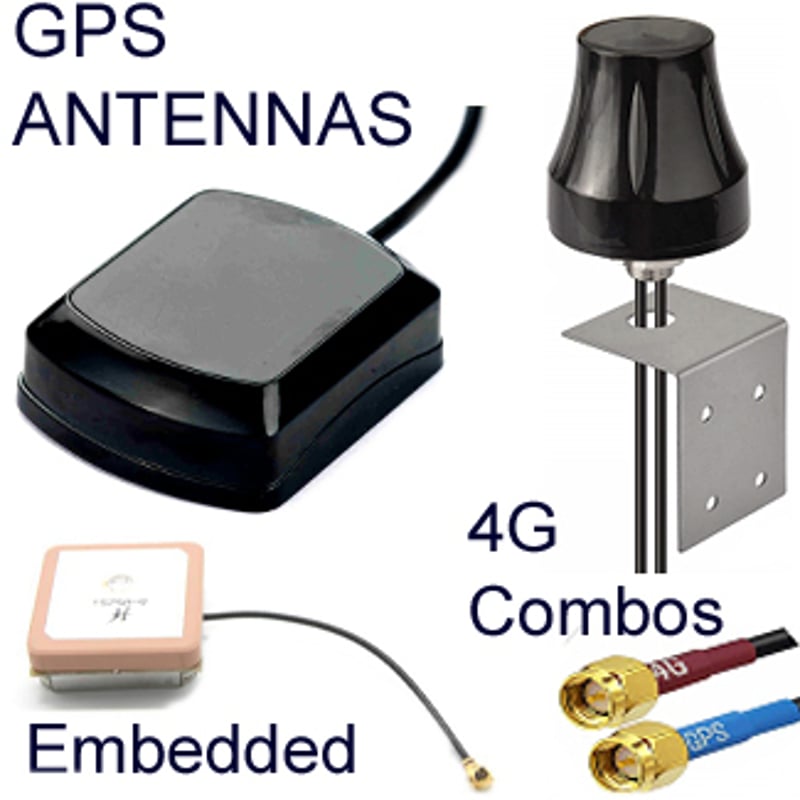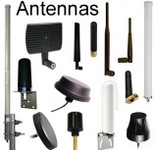GPS Antennas: Key Physical and Electrical Characteristics
What is a GPS antenna?
A GPS antenna is a radio frequency antenna that provides connectivity with the Global Positioning System, a proprietary, satellite-based radio navigation system designed, created, and owned by the United States Government. When appropriately connected to a GPS transceiver, the GPS antenna is able to transmit and receive the specific radio frequency signals needed for a GPS device to perform its time, location, and navigation functions. In performing this function GPS antennas become the key point of interaction between the satellites which form the GPS Space Segment and the GPS User segment (receivers).

The antenna must be suitably sensitive and possess the resonant necessary to detect the GPS signal broadcast by the satellite constellation and may often need a Low Noise Amplifier (LNA) to enhance the signal.
GPS antennas are connected to a GPS receiver, a satellite navigation device that possesses a front end interface and software to extract pertinent information from the received GPS signal and display it in a user-friendly format. The software and drivers involved must be capable of extracting information from the GPS signal despite its relatively low levels and usually involves further amplification of the signal and use of a range of correlation calculations and techniques. Positional data, routing directions, and other navigation may be displayed using maps or other proprietary methods. Types of GPS receivers vary from the professional survey and precision receivers to the commonly available Portable Navigation Devices (PNDs) used inside vehicles or integrated as part of smartphones or wearables.
Key physical and electrical characteristics of GPS or Global Navigation Satellite System GNSS antennas.
Sound GPS antenna design is vital because the GPS signal from the celestial constellation of satellites is not particularly strong. The antenna, therefore, plays a unique role in the final performance of a GPS enabled device.
A GPS antenna is comprised of:
● The antenna's radiating element will determine the antenna's bandwidth and other aspects of how it radiates electromagnetic energy.
● The antenna ground plane influences the radiation pattern of the antenna.
● An amplifier of some kind
● The antenna radome, that encloses the antennas and may influence its phase center. Phase center is important for GPS location as the position reported by a receiver typically refers to where the antenna captures the signal, known as the electrical phase center.
GPS antennas are usually high-efficiency antennas of 50-ohm impedance, making them compatible and well-matched with commonly available coaxial cable transmission lines.
The GPS signal is transmitted with right-handed circular polarization (RHCP) meaning that GPS antennas are usually RHCP and omnidirectional. The near hemispherical radiation pattern of these antennas means that the satellite signal can be received in any direction across the arc of the sky, from zenith to horizon.
In the US, the Federal Communications Commission (FCC) specifies limits of the amount of power that can be supplied to GPS antenna but within legal limits, these antennas have high gain, low directivity, and signal losses kept to an absolute minimum.

Antenna efficiency
They also make efficient use of the radiofrequency energy they receive, converting at least 50%, at a minimum, into radiated power.
Voltage Standing Wave Ratio (VSWR), the measure of the efficiency of transmission of electromagnetic energy from source to the antenna should be as low as possible but is acceptable at a ratio of 2:1 or less.
Positioning and orientation of the antenna should be optimized for good sky visibility at all times. To achieve the fastest Time To First Fix (TTFX), the antenna needs to be able to receive signals from as many antennas as possible. Poor visibility leads to positional drift and degradation inaccuracy of the navigational device. The mounting of these antennas is therefore of especial importance.
Types of GPS antenna
Here is a concise summary of the main types of GNSS antennas.
[A] Internalized or integrated GPS antennas are built into the GPS receiver device. They are most often patch antennas or quadrifilar antennas (more on these further on). These small antennas cannot be accessed directly, they are often mounted on a Printed Circuit Board (PCB). An optimal signal is obtained by positioning the whole device rather than the antenna alone.
[B] External GPS antennas are separate antennas that are connected to a GPS receiver via a length of GPS coaxial cable or suitable adapter. They are larger, higher gain, and are most often used in situations where a receiver with an internal antenna cannot pick up the signal as they can be readily mounted.
[C] Helix antennas consist of a wire that is coiled into a helix, to reduce the space that this internalized antenna will occupy. Multiplying the number of helices, as in a quad-helix antenna, where four helices are used, can increase the gain of the final antenna unit.
[D] Patch antennas are PCB antennas that consist of a two-dimensional foil geometric design called a fractal, that is connected to foil transmission lines and a ground plane. These low profile antennas are able to be embedded in materials like plastic and ceramic as part of an external antenna or within a GPS device.
[E] Active antennas are GPS antennas that have a low noise amplifier included to overcome the feedline losses associated with what is often a very weak signal. This improves the sensitivity of the antenna. An LNA shall be located close to the antenna with as little connecting feedline as possible to limit signal loss. LNAs work to amplify the radio navigation signal without altering or degrading it with amplifying any noise present. For optimal performance, LNA gain is usually at least 15 decibels and the Noise Factor of this type of amplifier is strictly limited to less than 1 decibel. Unlike a generic amplifier, the signal to noise ratio should not be worsened by an LNA. Active GPS antennas have additional power requirements which will be drawn from the receiving device's batteries. To save power the LNA should only be active when the antenna is in use.
[F] Passive antennas: These simple antennas do not have an LNA or alternate means of signal amplification and therefore do not require supplementary power. The cable length should be kept short, under 1 meter (3.3 feet), with passive GPS antennas as they require proximity to the receiver and minimal losses from the connecting line to perform optimally.
[G] Reradiating antennas: Paired antenna systems are known as reradiating antennas. One antenna is installed in close proximity to the GPS receiver and the other, a donor antenna, at a distance, where perhaps the signal is better. The two antennas are connected by a length of antenna extension cable and GPS antenna adapters. One of the most common uses is in vehicles where the reradiating antenna is mounted on the outside of the vehicle and connected to a receiver within. They are powered antennas so will require power either from the receiver or an auxiliary source. The use of GNSS repeaters is illegal in the UK outside of certain licensed circumstances.
[H] GPS antennas can be paired with LTE antennas to create an advantageous antenna system as we discuss below. The 4G antenna can be tuned to cover GPS and the GPS input should be isolated from the LTE/4G antenna. The antennas are connected via an auxiliary GPS antenna SMA connector to which a suitable 50-ohm antenna cable can be attached. This allows the signal to be looped between the two antennas. The primary antenna can transmit and receive and the auxiliary antenna receives only. Combo antennas can also perform this function.
[I] Parabolic antennas: These directional GPS antennas are equipped with a parabolic dish or reflector, which has a precisely curved shape that directs radio waves. They are only operational in a single direction, are high gain, and advantageous for monitoring or uplink purposes.
[J] Radome antennas: These GPS antennas feature a hemispherical some that houses and protects the antenna's radiating element and other key components from adverse environmental conditions. The Radome can be penetrated by the GPS radio signal and does not affect the antenna's center phase.
[K] Turnstile antennas: This GPS antenna structure consists of pairs of dipoles mounted perpendicularly to one another in a high gain arrangement. Depending on the orientation of the antenna, it may be horizontally or circularly polarized.
GPS antenna applications
The uses of GPS technology span a multitude of industries including:
- Marine
- Agriculture
- Transportation and Logistics
- Aviation
- Defense
- Emergency Services
- Infrastructure
- Security
GPS antennas can be broadly grouped according to their application:
- Handheld Receiver Antennas are this found in smartphones or dashboard-mounted devices and may be passive or active. Most of these antennas are narrowband, operating on a single frequency. They are common and usually lower cost, lighter weight, and have lower energy consumption than GPS antennas used for professional or industrial purposes. However, this also means that they are of low sensitivity and prone to interference.
- Geodetic Antennas are used for professional or industrial surveying work where precision measurements are essential. Roof mount antenna masts with high gain antenna arrays are connected to fixed receivers that are capable of the complex computations needed for measuring and understanding the earth's geometry, orientation, and gravitational fields.
- Rover Antennas provide accuracy for applications like forestry, construction, or engineering, where mobility will be needed. These GPS antennas are typically mounted at height on a movable pole or antenna tripod mount for surveying.
Why are GPS antennas important?
GPS antennas are integral to the functioning of the Global Positioning System and allowed users across the world to utilize this US-developed technology for:
- Positioning
- Navigation
- Timing Services
GPS, originally called NAVSTAR GPS was the first system of its kind in the world and has a broad range of applications from restricted military activity, to now being a near essential civil and consumer utility. GPS was first implemented in the 1970s and now comprises a constellation of 31 satellites that orbit at a height of over 21,000 km above the earth. The radio frequency signals transmitted at intervals from these satellites can be received and used by GPS receivers for time, location, and navigational purposes with unobstructed visibility from at least 4 orbiting satellites for positioning data with an accuracy of 30cm (11.8 inches) depending on the frequency band used. As this system is controlled and monitored by the United States military, and its performance can be degraded or access can be restricted by Executive Order. The Selective Availability program, implemented in the 1990s deliberately degraded the GPS signal for strategic military purposes but this was ended in the year 2000. The US Air Force mans an Operational Control Segment which oversees the deployment of GPS with 11 command and control antennas and numerous monitoring sites across the globe.
How does GPS work?
A working constellation of 24 satellites occupy a medium Earth orbit and are positioned so that at least 4 of these satellites are visible from any position on Earth. Within 24 hours each satellite will have circled the Earth twice, traveling at over 8,000 miles per hour (12,875 kilometers per hour).
While orbiting, the satellites continually emit a signal picked up by the receiver's GPS antenna. This signal contains data concerning the satellite's position and the time, as measured by synchronized atomic clocks carried within each satellite.
The specific components of the GPS signal are:
- Pseudorandom noise (PRN) code made up of zeros and ones, which is used to identify the communicating satellite.
- Ephemeris Data covers the date and time at the moment of the broadcast as well as the status of the broadcasting satellite.
- Almanac Data positional and location data and reporting on the entire constellation that can be used to determine the satellite's position relative to the Earth.
This data is under continual monitoring and correction where needed from the ground by the US Air force from various command and control centers.
Via their GPS antennas, receivers pick up the broadcasted signal and capture:
- Time of arrival (TOA)
- Time of flight (TOF)
This is the time taken for the broadcast signal to travel between the satellite and receiver. As the speed of the signal, the position of the broadcasting satellites and the time the signal was sent are known, the GPS receiver can use this data to calculate and plot its location, direction of travel and speed. Compensation is made in the calculation for the delay in the satellite signal as it passes through the upper atmospheric layers of the Earth.
GPS frequency bands
GPS signals are broadcast using the L-band of the radio frequency spectrum at sub-2 GHz frequencies that can overcome ionospheric delays and do not require a beam antenna for reception. This is because at these frequencies the radio waves will have good penetration of cloud, varying weather conditions like rain or fog and vegetation.
GPS antennas must be able to receive the satellite data broadcast on at least one of the two main carrier frequencies used.
● L1 which operates at 1575.42 MHz with a bandwidth of 15.345 MHz, and
● L2 which has a frequency of 1227.60 MHz and bandwidth of 11 MHz.
These bands provide civilian GPS access and when used in combination by dual-frequency receivers they provide fast signal acquisition, quick TTFF, reliable performance, and an enhanced operating range.
A third frequency band, the L5 band has been introduced for civilian use. It has a frequency of 1176.45 MHz and a bandwidth of 12.5 MHz. It has been devised to be robust and provide access for high-performance applications such as aviation and 'safety-of-life' purposes.
These frequencies are multiples of the base L-band frequency (10.23 MHz) of the atomic clock onboard the satellite. The PRN codes, ephemeris data, and almanac data are superimposed on L1 and L2 and their bandwidth must accommodate this.
GPS interference and limitations
GPS has undoubtedly had a transformational effect on navigation, but there are some intrinsic weaknesses in the system that limit its use in certain circumstances. Poor signal reception can be overcome to an extent by judicious use of an external GPS antenna but the problems listed below are commonly encountered irrespective of the antenna or receiver used.
- GPS multipath is a common source of error which is caused by a GPS antenna picking up not only the true satellite signals but also other radio waves that have been reflected or diffracted off buildings and other structures. It is much more likely to occur if there is no clear sky view of the antenna. These arrive at the receiver with a delay and cause interference with the miscalculation of position.
- Poor weather though GPS is able to penetrate adverse weather conditions, the GPS antenna may be affected by a build-up of ice or snow or being blown out of position by strong winds.
- Dense vegetation and tree canopy also produce reflections that impair the accuracy and utility of GPS.
- Urban/ built-up areas are challenging for GPS due to buildings that block the line of sight needed between satellites and antennas and multipath due to signal reflection off concrete and other dense materials.
- Indoor environments are enclosed and therefore have no direct visibility of the satellites and their walls and other structures cause attenuation of the signal. Even if there is some signal penetration into a building it is unlikely to be adequate.
- Energy consumption. Active GPS antennas are noted for their high energy consumption which can preclude not only prolonged use but also affect the design of devices, which often need a large battery.
- GPS receiver front-end software and mapping. Software and mapping errors and glitches will cause errors in the use of a GPS device. If maps are not updated, or they are improperly rendered, devices may give erroneous directions.
Frequently Asked Questions:
Are there alternatives to GPS?
GPS is the first and foremost of a number of radio navigation systems deployed by nations across the world. It is by far the most widely used system. Other Global Navigational Satellite Systems of note include:
- GLONASS or Global'naya Navigatsionnaya Sputnikovaya Sistema, is a Soviet and now Russian Federation administrated satellite navigation system that was launched in the 1980s. It has a constellation of 24 satellites.
- BeiDou is the Chinese radio navigation system that launched its first satellites in the year 2000. It initially offered regional coverage but has plans to deploy a constellation of 30 satellites for global coverage.
- Galileo is the European Union's satellite navigation system which is expected to deploy up to 30 satellites by 2020. Galileo has some compatibility with GPS.
Can I use my GPS antenna with an alternate radio navigation system?
GPS and GLONASS frequencies are close together and are therefore likely to be suitably received by a GPS antenna. However, the data from GLONASS or alternate systems are likely to be packaged differently to GPS which will affect the performance of the receiver and the LNA in particular. The only way to be sure that you can achieve compatibility across all the global satellite navigation systems is to use a Global Navigation Satellite Systems (GNSS) receiver and antenna that has multi-constellation functionality
What is assisted GPS?
A-GPS has been devised to reduce the time to first fix that may be encountered in built-up environments. It's particularly used with cellular phones and helps emergency call dispatchers locate a caller. A-GPS provides rapid start-up times by using external data sources such as the phone's ISP or nearest cellular base station to assist in locating the phone.
How should I mount a GPS antenna on a vehicle?
Installing a GPS antenna on a car or other vehicle needs to take into consideration the metal roof of the vehicle as well as any curvature or metal structures that could cause reflection of the signal. A GPS antenna should be positioned in the center of the roof as high as possible, away from metal structures like a roof rack. Magnetic roof antenna mounts may be used to provide adjustable positioning of the antenna on a metal roof.
In Conclusion
GPS antennas are key to the successful use of the Global Positioning System as they are tuned to receive and in most cases amplify the relatively weak signal from the orbiting satellites. GPS antenna type, design, and characteristics will impact not only sensitivity to the signal but also the design and utility of the GPS receiver, and its energy requirements in particular. Careful antenna mounting, taking advantage of exposure to the sky and line of sight wherever possible, will enable optimal system performance.
LEARN MORE:
Posted by George Hardesty on 16th Nov 2023

























